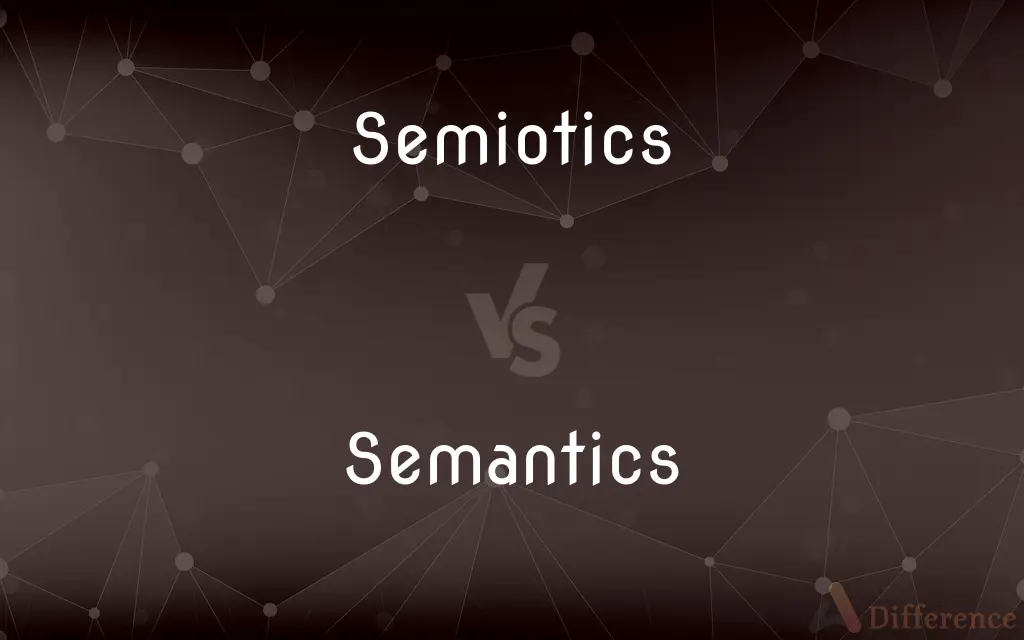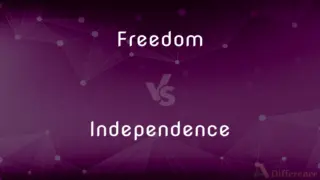Semiotics vs. Semantics — What's the Difference?
By Tayyaba Rehman & Fiza Rafique — Updated on March 8, 2024
Semiotics studies signs and symbols in communication, while semantics focuses on meaning in language.

Difference Between Semiotics and Semantics
Table of Contents
ADVERTISEMENT
Key Differences
Semiotics is the broader discipline that examines how signs and symbols function in conveying messages across various forms of communication, not limited to language but also including visual arts, music, and cultural practices. It explores the relationships between signifiers (forms that give signs their meaning, like words, images, sounds) and their signified concepts or objects. Semantics, on the other hand, is a branch of linguistics concerned specifically with the meaning of words, phrases, and sentences in language. It delves into how people understand and interpret language, including the meanings of words, their relationships, and how context affects interpretation.
While semiotics encompasses a wide range of sign systems and their roles in communication and interpretation, semantics narrows its focus to linguistic meaning, examining how language structures convey specific messages. Semiotics includes the study of symbols, signs, and sign processes (semiosis), investigating the ways in which meanings are constructed and understood in various contexts. Semantics concentrates on the linguistic aspects of meaning, such as synonymy (words with similar meanings), antonymy (words with opposite meanings), polysemy (words with multiple meanings), and how context influences the interpretation of language.
The methodologies of semiotics and semantics also differ. Semiotics applies a variety of theoretical and analytical frameworks to understand how signs operate within different systems of communication. It considers the cultural, social, and psychological factors influencing how signs are interpreted. Semantics typically uses linguistic analysis to explore how meaning is generated within language, relying on syntax (sentence structure), morphology (word formation), and pragmatics (the role of context in interpretation) to understand and explain how language conveys meaning.
The applications of semiotics extend beyond language, influencing fields such as cultural studies, anthropology, and marketing, where understanding how signs function can reveal deeper insights into human behavior and societal norms. Semantics, while also applicable in various contexts, is more directly concerned with language teaching, translation, and computational linguistics, aiming to enhance communication and understanding across different languages and cultural contexts.
Both semiotics and semantics are essential for understanding human communication, but they approach the study of signs and meanings from different perspectives. Semiotics offers a broad lens for exploring the role of signs in society and culture, while semantics provides a focused examination of how language functions to convey meaning.
ADVERTISEMENT
Comparison Chart
Focus
Signs and symbols across communication forms
Meaning in language
Scope
Broad, includes language, arts, and cultural practices
Narrow, limited to linguistic meaning
Key Concepts
Signifier, signified, semiosis
Synonymy, antonymy, polysemy, context
Methodologies
Theoretical and analytical frameworks
Linguistic analysis
Applications
Cultural studies, anthropology, marketing
Language teaching, translation, computational linguistics
Compare with Definitions
Semiotics
The study of signs and symbols as elements of communicative behavior.
Semiotics examines how a red rose can signify romance or passion.
Semantics
The branch of linguistics concerned with meaning in language.
Semantics studies how the word bank can mean the edge of a river or a financial institution.
Semiotics
Involves understanding how meaning is constructed and communicated.
Semiotics looks at how traffic lights communicate rules of behavior to drivers.
Semantics
Studies how context affects language interpretation.
Semantics looks at how the sentence I’m cold can mean different things in different situations.
Semiotics
Applies to both natural and artificial systems of signs.
Semiotics explores both human languages and computer codes as sign systems.
Semantics
Focuses on the interpretation of words, phrases, and sentences.
Semantics delves into why light can mean not heavy or not dark, depending on context.
Semiotics
A field that explores the interpretation of signs and symbols in various contexts.
In semiotics, the same sign can have different meanings depending on cultural contexts.
Semantics
Examines the relationships between words and meanings.
It analyzes how synonyms can have subtle differences in connotation.
Semiotics
Examines non-linguistic and linguistic sign systems.
The study includes how body language contributes to communication.
Semantics
Concerned with linguistic meaning and its use in communication.
Semantics is crucial for understanding jokes and puns in language.
Semiotics
Semiotics (also called semiotic studies) is the study of sign processes (semiosis), which are any activity, conduct, or process that involves signs, where a sign is defined as anything that communicates a meaning that is not the sign itself to the sign's interpreter. The meaning can be intentional such as a word uttered with a specific meaning, or unintentional, such as a symptom being a sign of a particular medical condition.
Semantics
Semantics (from Ancient Greek: σημαντικός sēmantikós, "significant") is the study of meaning, reference, or truth. The term can be used to refer to subfields of several distinct disciplines, including philosophy, linguistics and computer science.
Semiotics
The theory and study of signs and symbols, especially as elements of language or other systems of communication, and comprising semantics, syntactics, and pragmatics.
Semantics
The competence of a speaker with regard to the interpretation of the meaning of linguistic structures.
Semiotics
The study of signs and symbols, especially as means of language or communication.
Social science
Semantics
The study or science of meaning in language.
Semiotics
(dated) The study of medical signs and symptoms; symptomatology.
Semantics
The study of relationships between signs and symbols and what they represent. Also called semasiology.
Semiotics
Same as Semeiotics.
Semantics
The meaning or the interpretation of a word, sentence, or other language form
We're basically agreed.
Let's not quibble over semantics.
Semiotics
(philosophy) a philosophical theory of the functions of signs and symbols
Semantics
(linguistics) A branch of linguistics studying the meaning of words.
Semantics is a foundation of lexicography.
Semantics
The study of the relationship between words and their meanings.
Semantics
The individual meanings of words, as opposed to the overall meaning of a passage.
The semantics of the terms used are debatable.
The semantics of a single preposition is a dissertation in itself.
Semantics
(computer science) The meaning of computer language constructs, in contrast to their form or syntax.
File sharing and locking semantics
Semantics
The study of the meanings of words and of the sense development of words; - formerly called semasiology.
Semantics
A doctrine and philosophical approach to language and its relationship to thought and behavior, developed by Alfred Korzybski (1879-1950), which holds that the capacity to express ideas and thereby improve one's interaction with others and one's environment is enhanced by training in the more critical use of words and other symbols; - also called general semantics.
Semantics
The meanings of words as they are used to achieve an effect; especially, the multiple meanings of words or the multiplicity of words having the same meaning; - used in referring to the confusion that can be caused (intentionally or unintentionally) by multiple meanings; as, there's no real difference, it's only a matter of semantics.
Semantics
The study of language meaning
Common Curiosities
Can semantics be considered a part of semiotics?
Yes, semantics can be viewed as a branch of semiotics that specifically deals with linguistic signs and their meanings.
Are there overlaps between semiotics and semantics?
Yes, both fields study signs and meanings but from different scopes and perspectives. Semiotics encompasses a wider range of sign systems, including language, which is the specific focus of semantics.
What is a signifier and signified in semiotics?
The signifier is the form that the sign takes (e.g., a word, image, sound), and the signified is the concept it represents.
How does semiotics apply to cultural studies?
Semiotics helps analyze how cultural symbols and practices convey meanings and values, aiding in understanding societal norms and behaviors.
How do semiotics and semantics contribute to marketing?
Understanding how signs and meanings are interpreted can help in creating effective advertising and branding strategies that resonate with target audiences.
What is the main difference between semiotics and semantics?
Semiotics is the study of signs and symbols in all forms of communication, while semantics focuses on the meaning of words, phrases, and sentences in language.
Why is context important in semantics?
Context influences the interpretation of language, as it can significantly change the meaning of words and sentences.
What role does semiotics play in anthropology?
Semiotics aids in interpreting cultural signs and symbols, offering insights into human societies and their communication practices.
How does semiotics approach the study of visual arts?
It analyzes how images and visual elements function as signs, conveying meanings and emotions to viewers.
Can semiotics help in understanding non-verbal communication?
Yes, semiotics examines all types of communication, including non-verbal cues like gestures and facial expressions, and how they convey meaning.
Can the study of semantics improve language learning?
Yes, by understanding the meanings of words and how they change in different contexts, language learners can achieve greater proficiency and nuance in their second language.
How is polysemy relevant to semantics?
Polysemy, the phenomenon where a single word has multiple meanings, is a key area of study in semantics to understand how context determines meaning.
What is the significance of synonyms and antonyms in semantics?
They are important for understanding the nuances of language, illustrating the complexity of meanings and how words relate to each other.
Share Your Discovery

Previous Comparison
Freedom vs. Independence
Next Comparison
Feast vs. DinnerAuthor Spotlight
Written by
Tayyaba RehmanTayyaba Rehman is a distinguished writer, currently serving as a primary contributor to askdifference.com. As a researcher in semantics and etymology, Tayyaba's passion for the complexity of languages and their distinctions has found a perfect home on the platform. Tayyaba delves into the intricacies of language, distinguishing between commonly confused words and phrases, thereby providing clarity for readers worldwide.
Co-written by
Fiza RafiqueFiza Rafique is a skilled content writer at AskDifference.com, where she meticulously refines and enhances written pieces. Drawing from her vast editorial expertise, Fiza ensures clarity, accuracy, and precision in every article. Passionate about language, she continually seeks to elevate the quality of content for readers worldwide.















































